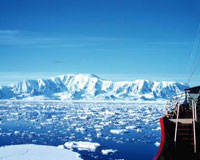World’s leading superpowers may soon launch war for Arctic and Antarctic riches
World’s leading superpowers may soon start fighting for Earth’s poles. It seems that the North Pole will be the first to be divided. The Artic territory was virtually divided during the 20th century into several zones currently owned by near-Arctic countries.

In the summer of 2008 Russia symbolically placed its flag on the bottom of the Arctic shelf, having spurred international controversy on the matter. A statement from Russia’s Ministry for Natural Resources said that the square of Russia’s expanded Arctic shelf will make up 1.2 million square kilometers with the hydrocarbon potential of 4.9 billion tons of fuel.
Russia’s Arctic initiatives made other countries launch their own endeavors on the development of the Arctic treasures.
Similar activities can be observed in the South Pole. Great Britain set out claims for a part of the Antarctic continent in October of the current year. The United Kingdom would like to obtain one million square kilometers of the Antarctic territory under its national jurisdiction. The square of the Antarctic totals 14 million square kilometers, which means that many other countries may put forward similar claims too. However, The Antarctic Treaty signed in 1959 says that the continent is considered to be the common property of mankind that can be divided under no circumstances.
It may seem at first sight that there is nothing valuable in Antarctica – only snow and ice. On the other hand, ice is the biggest value of the frozen continent: Antarctica holds up to 90 percent of world’s fresh water reserves. In addition, it is rich in fish and other biological resources.
Geologists say that the Antarctic shelf is rich with oil. Natural gas, coal, iron ore, copper, nickel, lead, zinc, molybdenum, and precious minerals can be found there too.
The struggle for the Antarctic riches began back in 1819, when the continent was discovered by Russian scientists Lazarev and Bellingshausen. Russia had been trying to reject other countries’ claims for the newly discovered land for 150 years. Eventually, Antarctica failed to become a part of Russia. The USSR and eleven other countries signed the Antarctic Treaty in 1959. It has been officially considered nobody’s land since that time. Furthermore, it is strictly forbidden to conduct industrial activities on the continent.
As experience shows, the issue of the national jurisdiction of Antarctica was simply delayed indefinitely. There is quite a number of countries that still view the frozen land as a source of immense income. For the time being, they conduct scientific research works there. Antarctica was divided into several national sectors, where 12 countries that signed the Antarctic Treaty in 1959 have their research missions.
Nevertheless, the continent became a center of yet another territorial dispute. Australia, for instance, believes that it has a right for a half of the Antarctic territory.
It is worthy of note that the first war for the Antarctic continent has already taken place. Britain and Argentina were in a legal dispute over the Falkland Islands for 25 years. London was actually aiming to strengthen its positions in the struggle for the sixth continent.
There are about 20 countries willing to obtain a piece of Antarctica nowadays. France, Japan and Norway, for instance, are struggling for both the North and the South poles. Japan claims that it is the only country that has the technology to develop Antarctic natural gas fields. Therefore, Japanese officials believe that their country has a full right to own a certain part of Antarctic natural resources.
World’s leading countries have thus been trying to obtain property rights for Antarctica that may come in handy in the near future. Experts say, though, that the political and technological competition may gradually develop into an armed struggle for the Antarctic and Arctic ice.
Utro
Translated by Dmitry Sudakov
Pravda.ru
Subscribe to Pravda.Ru Telegram channel, Facebook, RSS!


